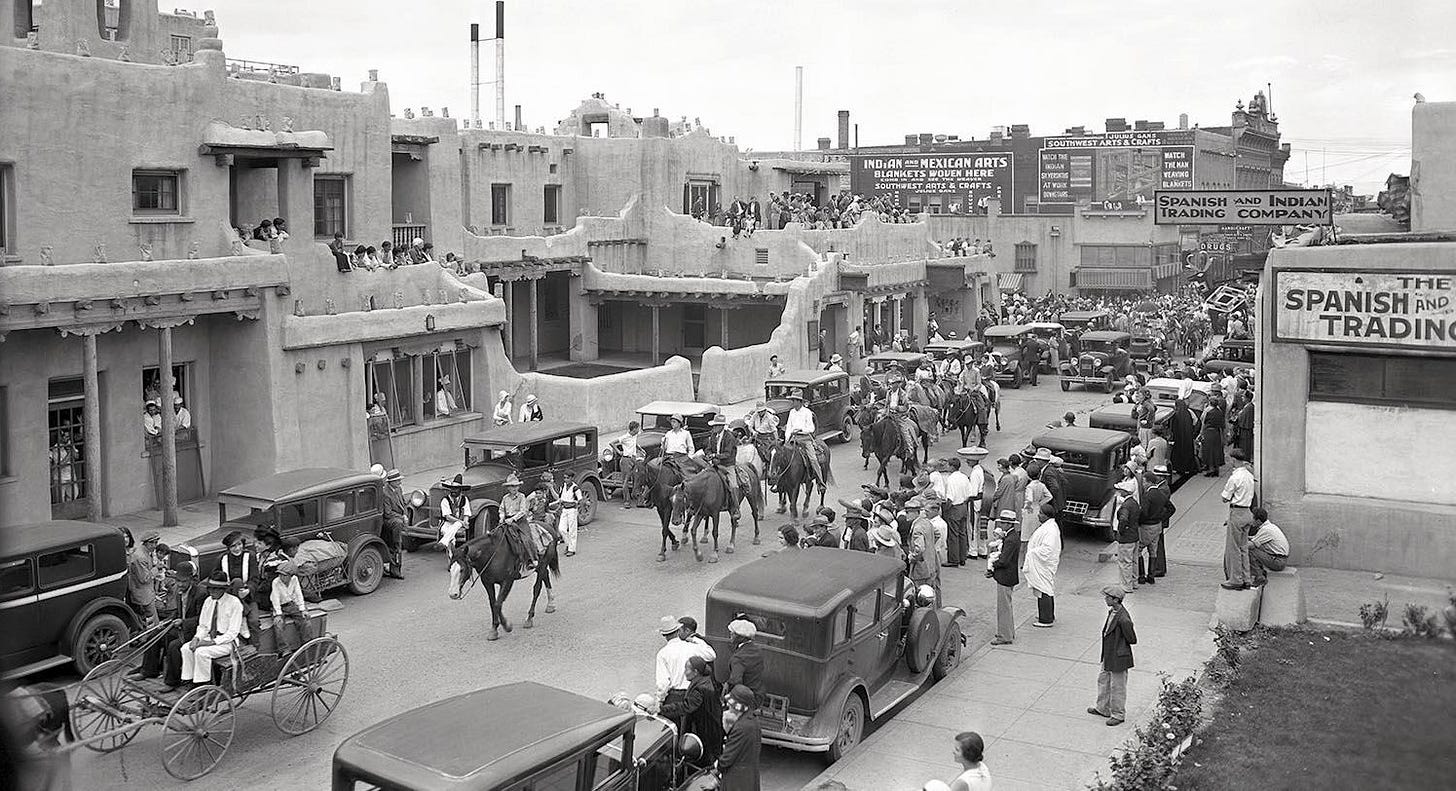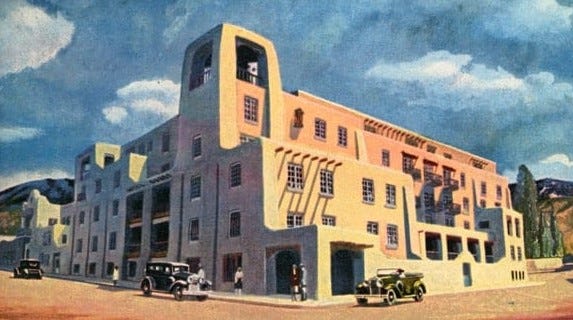Welcome to The Four Corners of the Southwest. My love for travel and the outdoors has inspired me to learn, research, and share interesting information about the American Southwest.
City records indicate that the current La Fonda, built in 1922, sits on the site of Santa Fe, New Mexico’s first inn established when the city was founded by the Spaniards in 1607.
In fact, the word “fonda” means “inn” in Spanish (Santa Fe means “Holy Faith”). In 1925, it was acquired by the Atchison, Topeka & Santa Fe Railway (AT&SF) and then leased to the Fred Harvey Company.
You can read about Fred Harvey (1835-1901), the entrepreneur, in one of my earlier posts.
The La Fonda has a rich history and intriguing stories that run the gamut from espionage to supernatural hauntings and it can still be visited today.

Becoming a Harvey House
La Fonda and the city of Santa Fe were already famous long before Fred Harvey or the Santa Fe Railroad came to town. In the mid-1920s the Harvey Company hired an architect, Mary Elizabeth Jane Colter, to work with John Gaw Meem to renovate and add on to the La Fonda. She is probably the best known for designing many of the buildings at the South Rim of the Grand Canyon while John Gaw Meem was considered the father of the Santa Fe Style. The hotel was enlarged from 46 to 156 rooms and Mary Colter completely refurnished the guest rooms, lounges and dining areas.
Dining at La Fonda featured the signature Harvey Girls, a staff of thoroughly well-trained waitresses who were famous for their role in the Harvey House success. The La Fonda Harvey Girls wore the traditional black-and-white uniforms in the dining room and lunchrooms but the women working outside on the patio wore colorful Mexican skirts and blouses.
Because of the large Hispanic and Native American population of the area, segregation was often nonexistent in local restaurants and hotels. The Harvey Houses of New Mexico served everyone who walked through the doors provided they could pay for their meal and had reasonable social habits. The “coat rule” for the dining room of Harvey establishments finally ended at the La Fonda. This was mainly due to the local painters, sculptures and writers who usually had their own “uniform” of brightly colored Mexican-type clothing.
In New Mexico, Harvey Houses were located across the state, from Albuquerque and Belen to Carlsbad, Clovis, Deming, Gallup, Lamy, Las Vegas, Raton, Rincon, San Marcial, and Vaughan. They’ve all disappeared except for La Fonda and La Castañeda in Las Vegas, which has been renovated by the same owners of La Posada, a fully restored Harvey House in Winslow, Arizona. A local Santa Fe businessman named Sam Allen acquired the La Fonda from the Fred Harvey Company in 1968.
Indian Detours
La Fonda was the headquarters for the famous Indian Detours, Fred Harvey’s automobile touring service which operated between 1926 and 1931. The longest New Mexico Indian Detour began after getting oof the train in Las Vegas, New Mexico touring for three to four days including Santa Fe and rejoining the train in Albuquerque.
There were well-appointed “Harveycars” that would be driven by men to take the tourists on these trips. The tours were led by Couriers who were women who were much more educated than Harvey Girls. The women who functioned as Couriers had to be college graduates and were given crash courses in southwestern art, geology, sociology, architecture and history.

Their uniform consisted of a long wool skirt, Indian velvet shirt, silver concha belt and leather boots. The women were paid $150 a month plus expenses with an additional $10 a month if they spoke Spanish.
Since the Depression reduced the number of tourists taking Detours, the operations were sold to local companies in the early 1930s.
Manhattan Project Espionage at La Fonda
During World War II, the first atomic bomb was built in Los Alamos, New Mexico, during World War II under a program called the Manhattan Project. Los Alamos is located approximately 40 miles northwest of Santa Fe.
The Manhattan Project had an office in Santa Fe just a block from the hotel in an adobe building located at 109 East Palace Avenue. When Oppenheimer first came to New Mexico to embark on the Project, his family stayed at La Fonda and took all their meals there.

The US Government immediately infiltrated the hotel staff (especially the Cantina) with undercover agents to help ensure the safety of scientists and secrets.
Because of the remoteness of Las Alamos, many of the scientists and their wives gathered socially at La Fonda. Because of this, both spies and undercover US agents monitored conversations because when drinking and thinking are combined, secrets may be spilled. Manipulating the situation, Oppenheimer asked physicists Bob Serber and John Manley to take their wives to La Fonda and deliberately plant rumors. Apparently, Charlotte Serber was a chatty woman and played her part well. The couples ordered drinks and talked loudly and obnoxiously about bombs equipped with some kind of “electromagnetic gun”.

Soviets Steal Secrets and Cold War Begins
One of the most important Soviet espionage operations of the 20th Century took place in Santa Fe. Two months before the atomic bomb was dropped on Japan (June, 1945), Los Alamos scientist Klaus Fuchs passed a packet of papers to Communist agent Harry Gold. The information that Fuchs stole from the Lab described the atomic bomb’s implosion mechanism. This information jumpstarted the Soviet Union’s nuclear weapons knowledge and launched the Cold War.
You can visit the place where the spies rendezvoused. You can synchronize your watches at the same jewelry store as the spies did (a block west of 109 East Palace Avenue) and walk a few blocks to the Paseo de Peralta Bridge (original bridge has been replaced) where the exchange took place.

Supernatural Residents at the La Fonda?
Because a building has been occupied in the same space for over four centuries, you’d figure that people would report ghostly encounters at La Fonda.
Firstly, the Honorable John P. Slough is said to roam the hallways and lobby. He was a judge who got into a deadly argument in the hotel’s lobby with a member of the Territorial Legislature of Dona Ana County in 1867. Slough called Captain Rynerson a liar and a thief. He may or may not have been, but he was a murderer after he shot Slough to death. The judge is said to wear a long, black coat as he roams.
Another apparition reported is of a man at the La Plazuela, a restaurant located in what was once the hotel’s inner courtyard. A businessman who drank and gambled away his fortune at the hotel was driven mad by his losses, so he ran to the inner courtyard and jumped headfirst into a deep well.
Finally, there’s a report of a ghost of a young bride who was murdered on her wedding night by an ex-lover. She is seen haunting room 510, the wedding suite as well as the lobby, an elevator and the basement.
Next Time
At the time that this post is released, I will be at the Bright Angel Lodge at Grand Canyon National Park in Arizona. I have been researching architect Mary Colter who helped decorate the La Fonda. However, her greatest and best-known work is at the Grand Canyon. I was inspired so thought I would head north from my home in Tucson for additional inspiration. My next post will be about Mary Colter and the one-of-a-kind buildings that she designed her at the Canyon.
I invite you to share this post to help support my work!









I love Santa Fe and I’ve stayed at La Fonda numerous times - the ghost stories would’ve made my visits much more interesting! Great article. If you are in Santa Fe, I would highly recommend having lunch or dinner at The Shed, but they have a three margarita limit!
An interesting story would be history of Evangelo’s bar just down from the Plaza
New Mexico is a fascinating state and during my travels we often stopped in Santa Fe and visited La Fonda restaurant. One of my favorite restaurants in the entire world! I had no idea of its rich history. Thank you so much for sharing another wonderfully written article about Americas Southwest! 🌵 💃